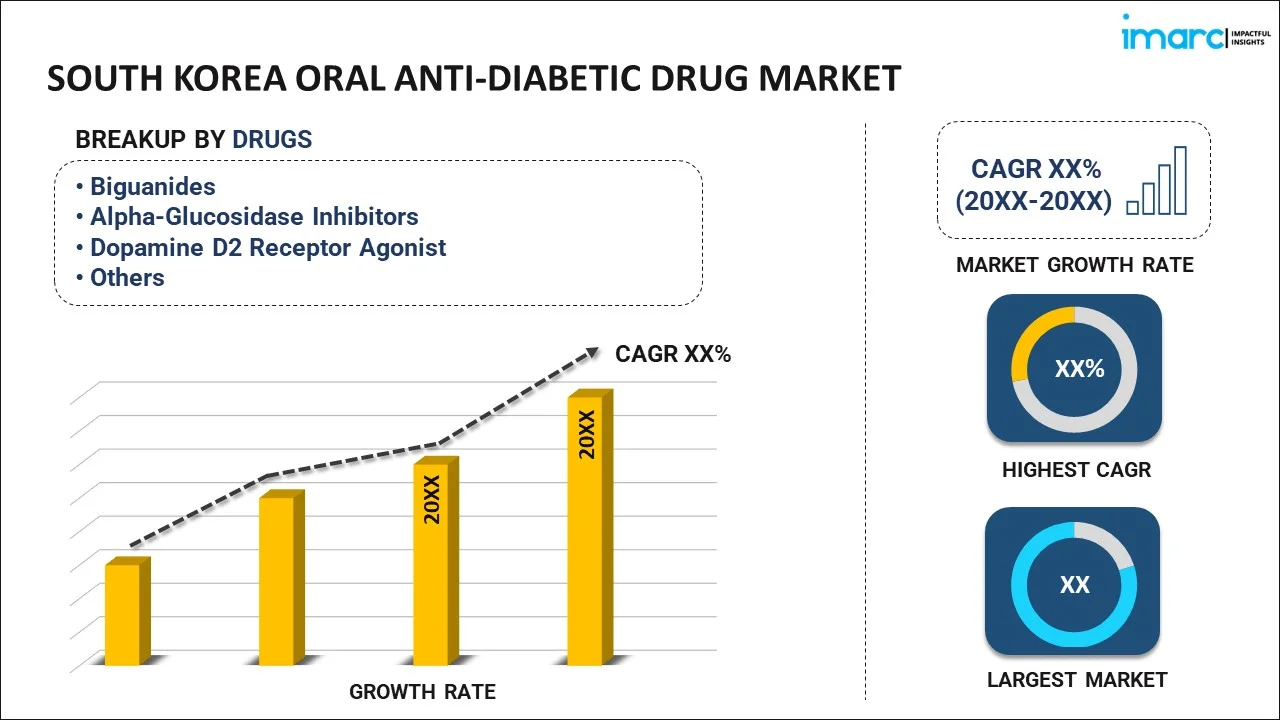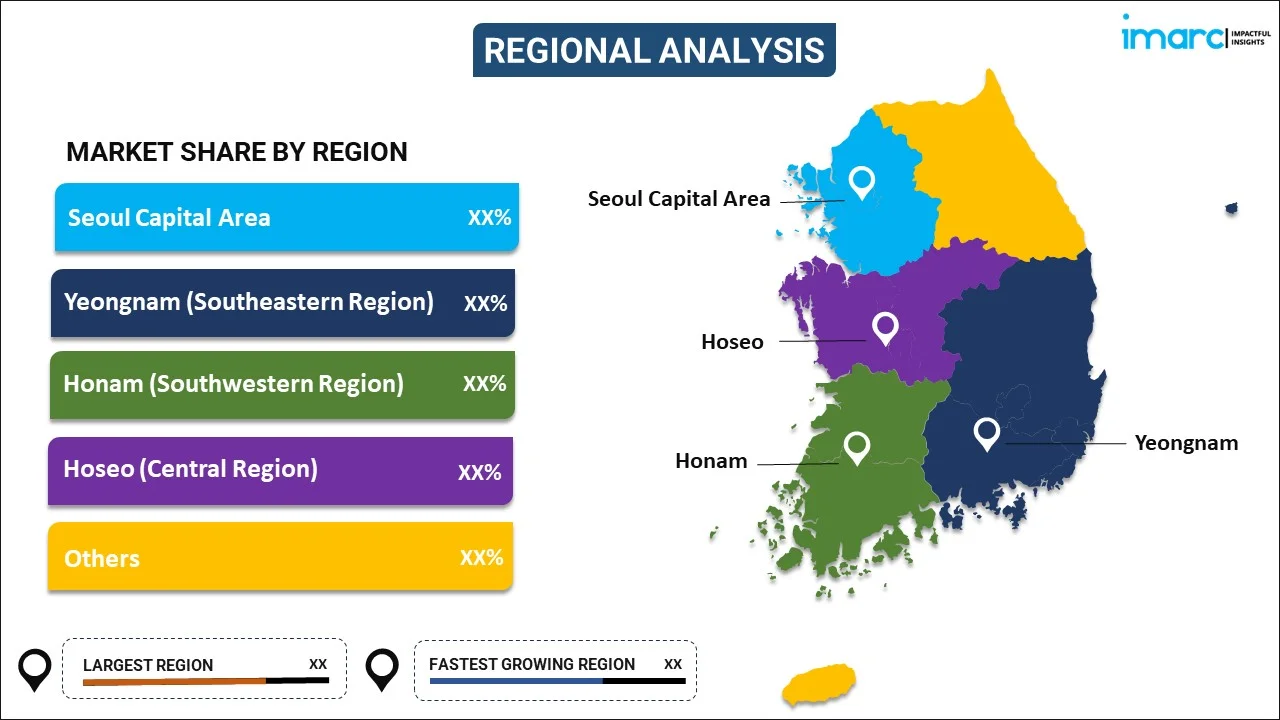
South Korea Oral Anti-Diabetic Drug Market Report by Drugs (Biguanides, Alpha-Glucosidase Inhibitors, Dopamine D2 Receptor Agonist, SGLT-2 Inhibitors, DPP-4 Inhibitors, Sulfonylureas, Meglitinides), and Region 2025-2033
Market Overview:
South Korea oral anti-diabetic drug market size reached USD 870.0 Million in 2024. Looking forward, IMARC Group expects the market to reach USD 1,180.0 Million by 2033, exhibiting a growth rate (CAGR) of 3.1% during 2025-2033. The growing prevalence of diabetes among the masses due to the adoption of unhealthy diets, increasing integration of smart devices with drug delivery mechanisms, and rising influence of patient advocacy groups represent some of the key factors driving the market.
|
Report Attribute
|
Key Statistics
|
|---|---|
|
Base Year
|
2024 |
|
Forecast Years
|
2025-2033
|
|
Historical Years
|
2019-2024
|
| Market Size in 2024 | USD 870.0 Million |
| Market Forecast in 2033 | USD 1,180.0 Million |
| Market Growth Rate (2025-2033) | 3.1% |
Oral anti-diabetic drug, also known as oral hypoglycemic agent, is a class of pharmaceutical compound specifically designed to lower blood sugar levels among individuals with diabetes. It comprises biguanides like metformin, which reduces the production of glucose and enhances insulin sensitivity. It also consists of sulfonylureas, such as glibenclamide and glipizide, which increases insulin production. It often enhances insulin production by the pancreas and improves the sensitivity of cells to insulin, allowing better glucose uptake. It also slows down the absorption of glucose in the gut and inhibits the production of glucose by the liver. It is often used in combination with each other or with insulin to achieve better glycemic control. It is more convenient than insulin injections, which can improve patient adherence to treatment plans. It also helps control blood sugar levels, reducing the risk of complications, such as heart disease, kidney disease, nerve damage, and vision problems. It allows healthcare providers to tailor treatments as per the age, severity of diabetes, and existing health conditions of an individual.
South Korea Oral Anti-Diabetic Drug Market Trends:
At present, the increasing prevalence of diabetes among the masses due to the consumption of unhealthy diets and the adoption of sedentary lifestyle habits represents one of the crucial factors impelling the growth of the market in South Korea. Besides this, the growing awareness about the importance of early diagnosis and treatment, coupled with improvements in healthcare infrastructure and accessibility, is expanding the patient pool seeking pharmacological interventions. In addition, the rising research and development (R&D) activities are facilitating the production of various novel drugs that are not only effective in managing blood sugar levels, but also offer additional benefits, such as weight loss and cardiovascular risk reduction. Apart from this, the integration of smart devices with drug delivery mechanisms enables real-time monitoring and personalized dosing adjustments, thereby contributing to better disease management. Furthermore, combination therapies that combine multiple drug classes in a single medication are prescribed by doctors to address the multifaceted nature of diabetes are simplifying treatment regimens for patients and improving medication adherence. Moreover, the growing influence of patient advocacy groups and the increasing role of social media in healthcare is bolstering the market growth in the country. Furthermore, patients are becoming more involved in their treatment decisions and are demanding drugs that not only effectively manage diabetes but also align with their lifestyle and preferences. This trend is pushing pharmaceutical companies operating in the country to focus on patient feedback and develop medications that cater to these evolving needs.
South Korea Oral Anti-Diabetic Drug Market Segmentation:
IMARC Group provides an analysis of the key trends in each segment of the market, along with forecasts at the country level for 2025-2033. Our report has categorized the market based on drugs.
Drugs Insights:

- Biguanides
- Metformin
- Alpha-Glucosidase Inhibitors
- Dopamine D2 Receptor Agonist
- Bromocriptin
- SGLT-2 Inhibitors
- Invokana (Canagliflozin)
- Jardiance (Empagliflozin)
- Farxiga/Forxiga (Dapagliflozin)
- Suglat (Ipragliflozin)
- DPP-4 Inhibitors
- Onglyza (Saxagliptin)
- Tradjenta (Linagliptin)
- Vipidia/Nesina (Alogliptin)
- Galvus (Vildagliptin)
- Sulfonylureas
- Meglitinides
The report has provided a detailed breakup and analysis of the market based on the drugs. This includes biguanides (metformin), alpha-glucosidase inhibitors, dopamine D2 receptor agonist (bromocriptin), SGLT-2 inhibitors (invokana (canagliflozin), jardiance (empagliflozin), farxiga/forxiga (dapagliflozin), and suglat (ipragliflozin)), DPP-4 inhibitors (onglyza (saxagliptin), tradjenta (linagliptin), vipidia/nesina (alogliptin), and galvus (vildagliptin)), sulfonylureas, and meglitinides.
Regional Insights:

- Seoul Capital Area
- Yeongnam (Southeastern Region)
- Honam (Southwestern Region)
- Hoseo (Central Region)
- Others
The report has also provided a comprehensive analysis of all the major regional markets, which include Seoul Capital Area, Yeongnam (Southeastern Region), Honam (Southwestern Region), Hoseo (Central Region), and Others.
Competitive Landscape:
The market research report has also provided a comprehensive analysis of the competitive landscape in the market. Competitive analysis such as market structure, key player positioning, top winning strategies, competitive dashboard, and company evaluation quadrant has been covered in the report. Also, detailed profiles of all major companies have been provided.
South Korea Oral Anti-Diabetic Drug Market Report Coverage:
| Report Features | Details |
|---|---|
| Base Year of the Analysis | 2024 |
| Historical Period | 2019-2024 |
| Forecast Period | 2025-2033 |
| Units | Million USD |
| Scope of the Report | Exploration of Historical and Forecast Trends, Industry Catalysts and Challenges, Segment-Wise Historical and Predictive Market Assessment:
|
| Drugs Covered |
|
| Regions Covered | Seoul Capital Area, Yeongnam (Southeastern Region), Honam (Southwestern Region), Hoseo (Central Region), Others |
| Customization Scope | 10% Free Customization |
| Post-Sale Analyst Support | 10-12 Weeks |
| Delivery Format | PDF and Excel through Email (We can also provide the editable version of the report in PPT/Word format on special request) |
Key Questions Answered in This Report:
- How has the South Korea oral anti-diabetic drug market performed so far and how will it perform in the coming years?
- What has been the impact of COVID-19 on the South Korea oral anti-diabetic drug market?
- What is the breakup of the South Korea oral anti-diabetic drug market on the basis of drugs?
- What are the various stages in the value chain of the South Korea oral anti-diabetic drug market?
- What are the key driving factors and challenges in the South Korea oral anti-diabetic drug?
- What is the structure of the South Korea oral anti-diabetic drug market and who are the key players?
- What is the degree of competition in the South Korea oral anti-diabetic drug market?
Key Benefits for Stakeholders:
- IMARC’s industry report offers a comprehensive quantitative analysis of various market segments, historical and current market trends, market forecasts, and dynamics of the South Korea oral anti-diabetic drug market from 2019-2033.
- The research report provides the latest information on the market drivers, challenges, and opportunities in the South Korea oral anti-diabetic drug market.
- Porter's five forces analysis assist stakeholders in assessing the impact of new entrants, competitive rivalry, supplier power, buyer power, and the threat of substitution. It helps stakeholders to analyze the level of competition within the South Korea oral anti-diabetic drug industry and its attractiveness.
- Competitive landscape allows stakeholders to understand their competitive environment and provides an insight into the current positions of key players in the market.
Need more help?
- Speak to our experienced analysts for insights on the current market scenarios.
- Include additional segments and countries to customize the report as per your requirement.
- Gain an unparalleled competitive advantage in your domain by understanding how to utilize the report and positively impacting your operations and revenue.
- For further assistance, please connect with our analysts.
 Request Customization
Request Customization
 Speak to an Analyst
Speak to an Analyst
 Request Brochure
Request Brochure
 Inquire Before Buying
Inquire Before Buying




.webp)




.webp)












